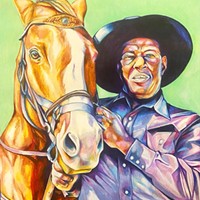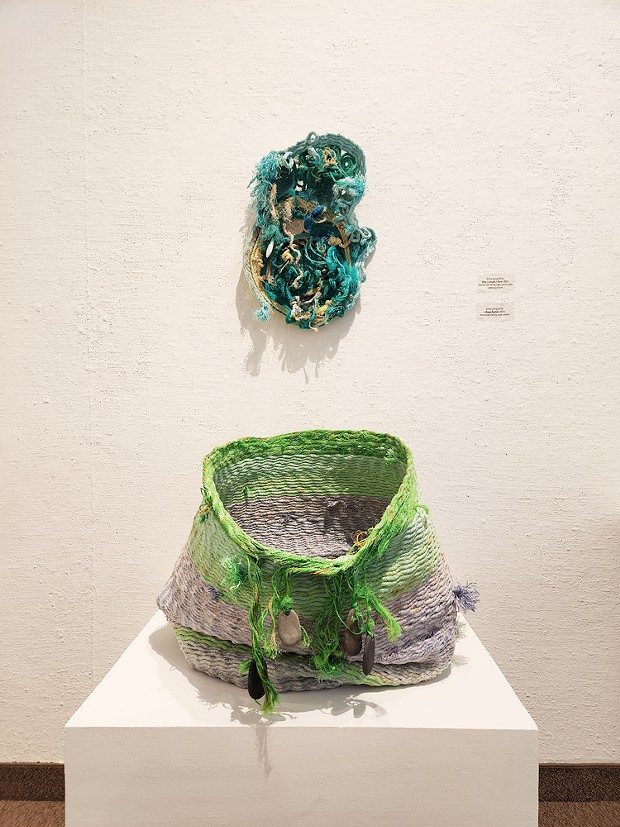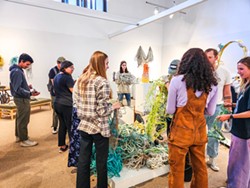Sea of Possibilities
Emily Jung Miller's Ghost Net Landscape at the Reese Bullen Gallery
By L.L. Kessner[
{
"name": "Top Stories Video Pair",
"insertPoint": "7",
"component": "17087298",
"parentWrapperClass": "fdn-ads-inline-content-block",
"requiredCountToDisplay": "1"
}
]
"I think I've always looked for the forgotten places," says Oregon-based artist Emily Jung Miller. "I feel an honesty and also a mystery in the silent stories told by things left behind," she explains. "Over time, nature transforms our human creations into something new and collaborative."
Ghost Net Landscape, Miller's current exhibition at Cal Poly Humboldt's Reese Bullen Gallery, transforms marine debris into art that evolves over time with the participation of its viewers. Ghost Net Landscape showcases Miller's sculptural constructions, mostly handmade baskets and a few hanging pieces, which are built from the raw material of discarded fishing nets and rope and other industrial artifacts retrieved from the ocean. The show is also a continually evolving installation. Visitors to the gallery are invited to contribute to the artwork by making their own objects out of the same reclaimed material. Miller says that, in its new context, the raw material. which is detrimental to marine life and to the ecosystem when left in the sea, feels like treasure rather than trash. "The richness of its history gives it life."
There is a table of tools and gloves and wire for community use just inside the doors of the gallery. Amid the arrangement of Miller's baskets on pedestals, there is a central platform with tubs of heavy, brightly colored netting and rope, all dragged from the ocean. Attendants offer advice on the proper use of the tools, and visitors — if they choose — can go to work with the materials, constructing new objects to display on the walls and in the back of the gallery. Like any landscape, it evolves and reemerges each day as a new formulation of itself, based on the actions of its inhabitants.
CPH student Skyler Friedland visited the show and was impressed with the "inclusive" aspect that allows viewers to make work in the show. Fellow student Sam Poplewko reflected on the act of making art out of materials from our own coast and noted that Ghost Net Landscape can open students' minds about art and the environment. Charlie Burrowes commented that the exhibition's "repurposing [of] harmful waste that really has nowhere else to go was just incredible."
What makes Miller's work unique among contemporary work that utilizes discarded objects as material to process our collective environmental anxiety, is its solution-focused positivity and its focus on community participation. Miller states, "Ghost Net Landscape is about transformation. The project's mission is to create space where positive transformation is a natural and joyful response."
Miller's hands-on engagements with the debris turns it into surprising, vibrant visual forms. Describing her process, she says, "Sometimes I have an idea in advance, but mostly I just choose a few colors I want to see together and see where the material takes me. ... What happens if I turn the piece inside out, halfway through?" she asks. "How can I include knotted pieces and thicker pieces that really show that material history?"
Miller describes herself as a mixed-race Chinese American who relocated from Kauai to Oregon in 2014. She currently lives near the forested foothills of the Coast Range west of Portland Oregon, where she has maintained a full-time studio practice since 2016. She says that her art has its roots in "love of the sea."
Of the ocean, Miller states, "There is no speaking, no doing, nothing required. When I need to center myself, I imagine swimming out from shore until I can only see the waves around me. It sounds kind of scary when I describe it but it feels so restful. That sense of rest and security in the infinite is something I try to include in my work, although I'm not sure how clearly it comes through."
Connecting with the ocean through its pollution, Ghost Net Landscape presents solutions and hope beyond the familiar problematization. It gives the community something to do, not with the totality of the world's pollution problems, but with our own experience of anxiety. It presents an opportunity to transform one part, a tangible prototype of transmutation.
Miller describes the exhibit's presentation of massed raw materials as speaking "to the global magnitude and complexity of this issue." She writes, "Ghost Net Landscape is a sanctuary and a prayer, not located outside the issue as a place to escape, but rather completely created from it." The exhibition "uses the materials themselves to ask what each of us will create, how each of us will transform and grow in a shared and joyful collaboration towards a more sustainable and equitable future."
The public can view the exhibition and participate in its evolution through Oct. 14 in the Reese Bullen Gallery, located in the CPH Art Building, across from the Van Duzer Theatre, Wednesdays and Thursdays from noon to 6 p.m., Fridays 11 a.m. to 5 p.m., Saturdays 11 a.m. to 2p.m., or by appointment. Email [email protected] or call (707) 826-5818.
L.L. Kessner is an Arcata-based artist and writer.
Speaking of...
-

Self Definition in My Black Is ...
Nov 17, 2022 - More »
more from the author
-
New Art Sellers Around Old Town:
Stock Schlueter Fine Art and 4th Street Mercantile
- Jan 25, 2024
-
Full Circle Journey
Robert Benson's Tintah: Amongst the Trails at the Goudi'ni Native American Arts Gallery
- Oct 26, 2023
- More »

































